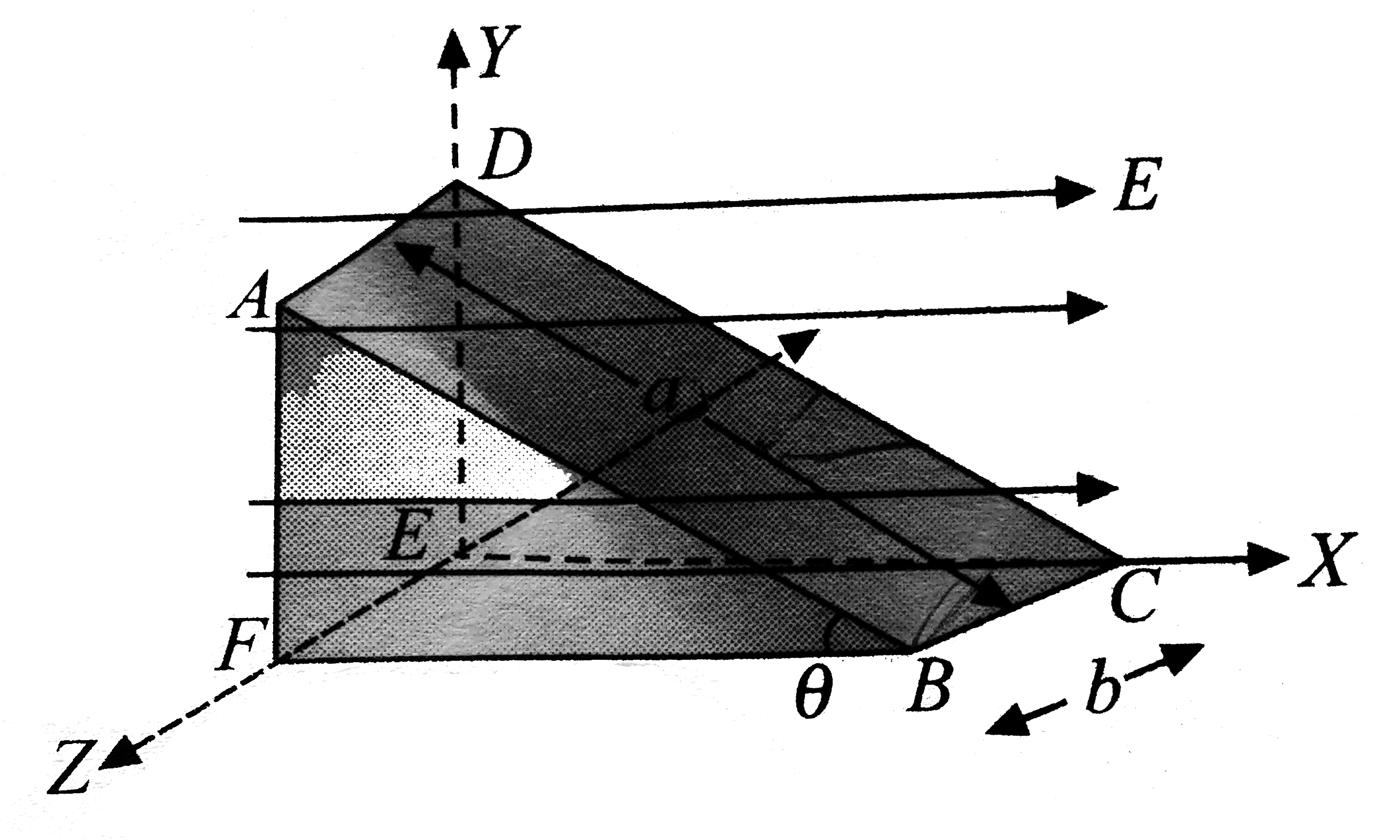The length and radius of a cylinder are L and R respectively. The total flux for the surface of the cylinder, when it is placed in a uniform electric field E parallel to the axis of the cylinder is
zero
2πR2E
2πR2E
πR2E
The correct Answer is:A
To find the total electric flux through the surface of a cylinder placed in a uniform electric field E parallel to the axis of the cylinder, we can follow these steps:
1. Identify the Surfaces of the Cylinder:
The cylinder has three surfaces:
- Two circular ends (let's call them Surface 1 and Surface 2).
- One curved surface (let's call it Surface 3).
2. Understand the Orientation of the Electric Field:
The electric field E is parallel to the axis of the cylinder. This means that the electric field lines are running along the length of the cylinder.
3. Calculate Electric Flux for Each Surface:
- Surface 1 (one circular end):
The area vector →A1 is perpendicular to the surface and points outward. The angle between the electric field →E and the area vector →A1 is 180∘ (since they are in opposite directions).
Φ1=→E⋅→A1=E⋅A1⋅cos(180∘)=−E⋅πR2
- Surface 2 (the other circular end):
The area vector →A2 for this surface also points outward, but the electric field is in the same direction as the area vector. The angle between →E and →A2 is 0∘.
Φ2=→E⋅→A2=E⋅A2⋅cos(0∘)=E⋅πR2
- Surface 3 (the curved surface):
For the curved surface, the area vector is perpendicular to the electric field at every point on the surface. The angle between →E and the area vector →A3 is 90∘.
Φ3=→E⋅→A3=E⋅A3⋅cos(90∘)=0
4. Sum the Electric Fluxes:
Now, we can find the total electric flux Φ through the entire surface of the cylinder by summing the contributions from all three surfaces:
Φ=Φ1+Φ2+Φ3
Substituting the values we calculated:
Φ=(−E⋅πR2)+(E⋅πR2)+0=0
Final Result:
The total electric flux through the surface of the cylinder is:
Φ=0
The cylinder has three surfaces:
- Two circular ends (let's call them Surface 1 and Surface 2).
- One curved surface (let's call it Surface 3).
The electric field E is parallel to the axis of the cylinder. This means that the electric field lines are running along the length of the cylinder.
- Surface 1 (one circular end):
The area vector →A1 is perpendicular to the surface and points outward. The angle between the electric field →E and the area vector →A1 is 180∘ (since they are in opposite directions).
Φ1=→E⋅→A1=E⋅A1⋅cos(180∘)=−E⋅πR2
The area vector →A2 for this surface also points outward, but the electric field is in the same direction as the area vector. The angle between →E and →A2 is 0∘.
Φ2=→E⋅→A2=E⋅A2⋅cos(0∘)=E⋅πR2
For the curved surface, the area vector is perpendicular to the electric field at every point on the surface. The angle between →E and the area vector →A3 is 90∘.
Φ3=→E⋅→A3=E⋅A3⋅cos(90∘)=0
Now, we can find the total electric flux Φ through the entire surface of the cylinder by summing the contributions from all three surfaces:
Φ=Φ1+Φ2+Φ3
Substituting the values we calculated:
Φ=(−E⋅πR2)+(E⋅πR2)+0=0
The total electric flux through the surface of the cylinder is:
Φ=0
Topper's Solved these Questions
- ELECTRIC CHARGES AND FIELDSBOOK - NARAYNACHAPTER - ELECTRIC CHARGES AND FIELDSEXERCISE - C.U.Q
81 Videos
- ELECTRIC CHARGES AND FIELDSBOOK - NARAYNACHAPTER - ELECTRIC CHARGES AND FIELDSEXERCISE - EXERCISE -1 (C.W)
24 Videos
- ELECTRIC CHARGES AND FIELDSBOOK - NARAYNACHAPTER - ELECTRIC CHARGES AND FIELDSEXERCISE - EVALUATE YOURSELF-3
7 Videos
- DUAL NATUREBOOK - NARAYNACHAPTER - DUAL NATUREEXERCISE - LEVEL-II (H.W)
17 Videos
- ELECTRO MAGNETIC INDUCTIONBOOK - NARAYNACHAPTER - ELECTRO MAGNETIC INDUCTIONEXERCISE - Level-II (H.W)
23 Videos
Similar Questions
Knowledge Check
The electric flux through a hemispherical surface of radius R placed in a uniform electric field E parallel to the axis of the circular plane is
A(2πR)EB(πR2)EC(43πR3)ED(23πR3)EA cylinder of radius R and length L is placed in a uniform electric field E parallel to the axis. The total flux for the surface of the cylinder is given by
A2πR2EBπR2/EC(πR2−πR)EDzeroA cylinder of radius R and length l is placed in a uniform electric field E parallel to the axis of the cylinder. The total flux over the curved surface of the cylinder is
AzeroBπR2EC2πR2EDE/πR2
There is a long cylinder of radius R having a cylindrical cavity of radius R/2 as shown in the figure. Apart from the cavity, the entire space inside the cylinder has a uniform mag- netic field parallel to the axis of the cylinder. The magnetic field starts changing at a uniform rate of dBdt=kT/s. Find the induced electric field at a point inside the cavity.

View SolutionElectric field due to cylinders
View SolutionA cylinder of radius r and length l is placed in an uniform electric field parallel to the axis of the cylinder. The total flux for the surface of the cylinder is given by-
View SolutionA cylinder of radius R and length L is placed in a uniform electric field E parallel to the axis. The total flux for the surface of the cylinder is given by
View SolutionA cylinder of radius R and length L is placed in a uniform electric field E parallel to the axis. The total flux for the surface of the cylinder is given by
View Solution

